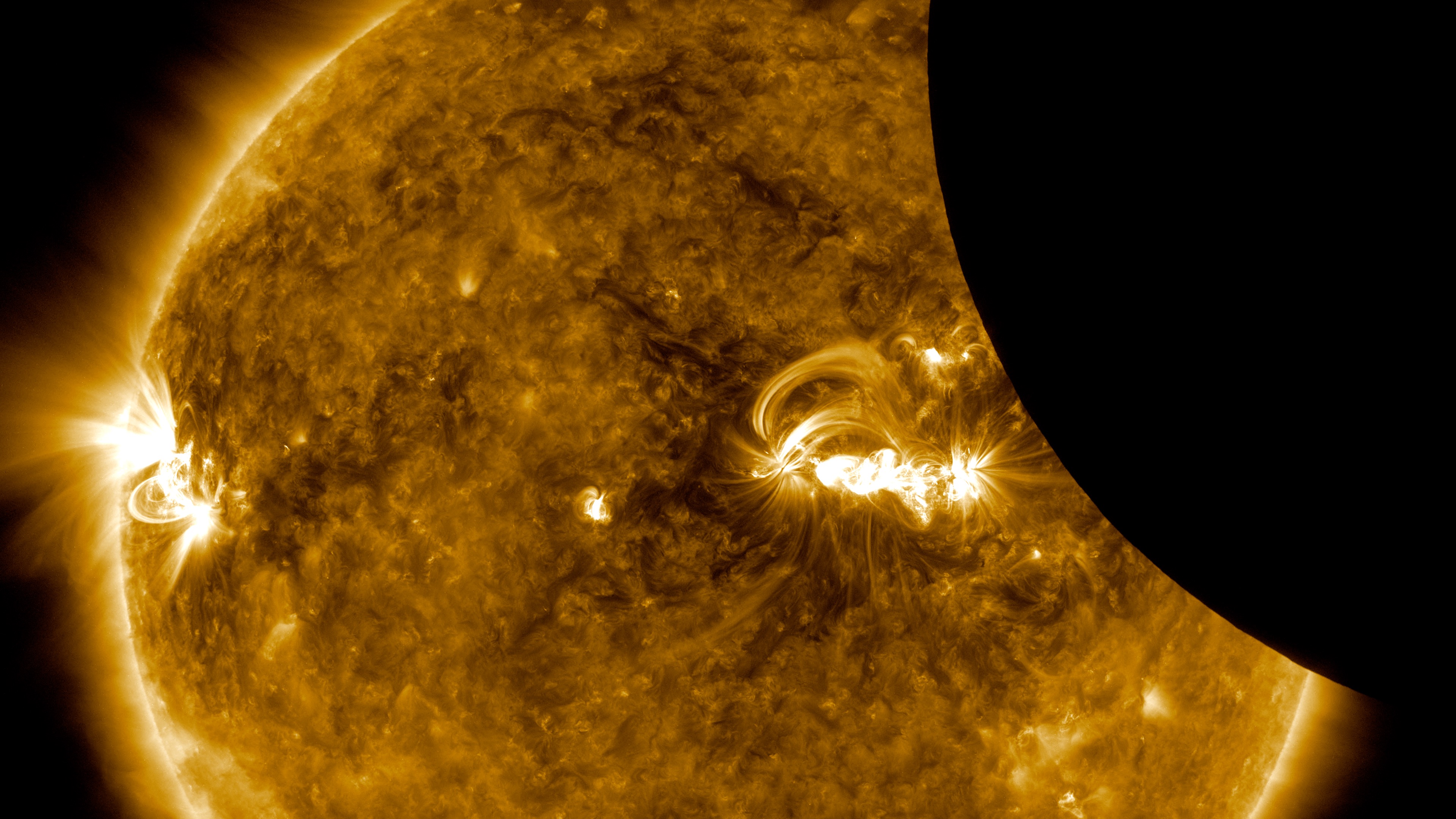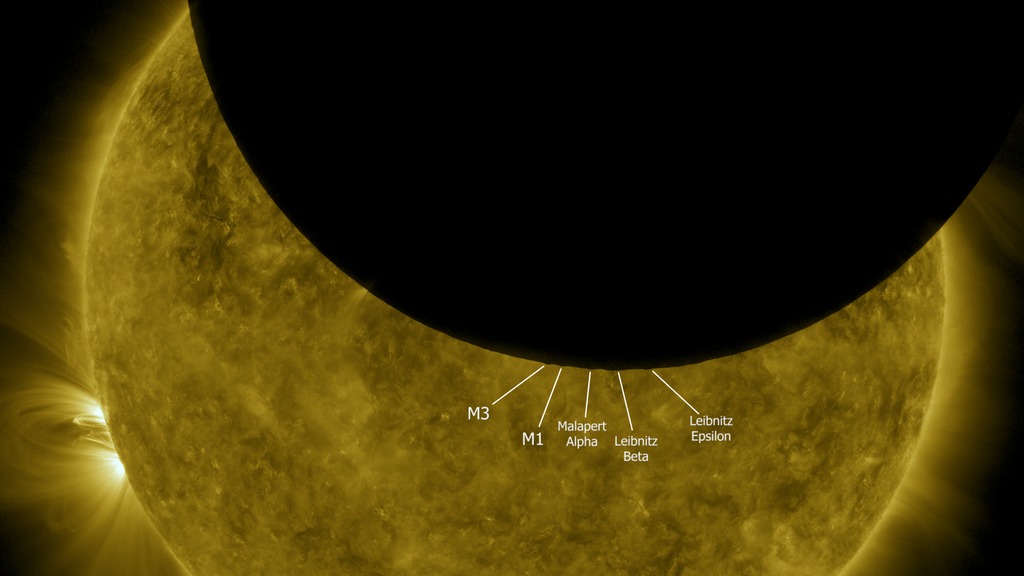The Moon and the Sun: Two NASA Missions Join Their Images
Two or three times a year, NASA’s Solar Dynamics Observatory observes the moon traveling across the sun, blocking its view. While this obscures solar observations for a short while, it offers the chance for an interesting view of the shadow of the moon. The moon’s crisp horizon can be seen up against the sun, since the moon does not have an atmosphere. (At other times of the year, when Earth blocks SDO’s view, the Earth’s horizon looks fuzzy due to its atmosphere.)
If one looks closely at such a crisp border, the features of the moon’s topography are visible, as is the case in this image from Oct. 7, 2010. This recently inspired two NASA visualizers to overlay a 3-dimensional model of the moon based on data from NASA’s Lunar Reconnaissance Orbiter into the shadow of the SDO image. Such a task is fairly tricky, as the visualizers — Scott Wiessinger who typically works with the SDO imagery and Ernie Wright who works with the LRO imagery — had to precisely match up data from the correct time and viewpoint for the two separate instruments. The end result is an awe-inspiring image of the sun and the moon.
To start the process, the visualizers took the viewing position and time from the SDO image. This information was dropped into an LRO model that can produce the exact view of the moon from anywhere, at any time, by incorporating 6 billion individual measurements of the moon’s surface height from LRO’s Lunar Orbiter Laser Altimeter instrument. The model had to take many factors into consideration, including not only SDO’s distance and viewing angle, but also the moon’s rotation and constant motion. Wright used animation software to wrap the elevation and appearance map around a sphere to simulate the moon.
The two images were put together and the overlay was exact. The mountains and valleys on the horizon of the LRO picture fit right into the shadows seen by SDO.
In its own way, this served as a kind of calibration of data. It means that the SDO data on its position and time is highly accurate and that the LRO models, too, are able to accurately provide images of what’s happening at any given moment in time.
And of course, the whole exercise provides for a beautiful picture.

This image is a view of the sun captured by NASA’s Solar Dynamics Observatory on Oct. 7, 2010, while partially obscured by the moon. A close look at the crisp horizon of the moon against the sun shows the outline of lunar mountains. A model of the moon from NASA’s Lunar Reconnaissance Orbiter has been inserted into the picture, showing how perfectly the moon's true topology fits into the shadow observed by SDO.
Credit: NASA/SDO/LRO/GSFC

SDO and LRO composite with artificially rim-lit moon.
Credit: NASA/SDO/LRO/GSFC

SDO and LRO composite with artificially rim-lit moon.
Cropped version.
Credit: NASA/SDO/LRO/GSFC

This is an up close shot of two NASA images: An image rendered from a model of the moon from the Lunar Reconnaissance Orbiter overlaid onto an image of the sun from the Solar Dynamics Observatory, during a lunar transit as seen by SDO on Oct. 7, 2010. The various features of the moon’s horizon are labeled.
Credit: NASA/SDO/LRO/GSFC

This is an up close shot of two NASA images: An image rendered from a model of the moon from the Lunar Reconnaissance Orbiter overlaid onto an image of the sun from the Solar Dynamics Observatory, during a lunar transit as seen by SDO on Oct. 7, 2010. Unlabeled version.
Credit: NASA/SDO/LRO/GSFC

This is an up close shot of two NASA images: An image rendered from a model of the moon from the Lunar Reconnaissance Orbiter overlaid onto an image of the sun from the Solar Dynamics Observatory, during a lunar transit as seen by SDO on Oct. 7, 2010. Shifting the moon image slightly shows how well the lunar features match the outline in the SDO image.
Credit: NASA/SDO/LRO/GSFC

This image is a view of the sun captured by NASA’s Solar Dynamics Observatory on Oct. 7, 2010, while partially obscured by the moon. A close look at the crisp horizon of the moon against the sun shows the outline of lunar mountains. A model of the moon from NASA’s Lunar Reconnaissance Orbiter has been inserted into the picture, showing how perfectly the moon's true topology fits into the shadow observed by SDO. This version shows the complete moon.
Credit: NASA/SDO/LRO/GSFC

This image is a view of the sun captured by NASA’s Solar Dynamics Observatory on Oct. 7, 2010, while partially obscured by the moon. A close look at the crisp horizon of the moon against the sun shows the outline of lunar mountains.
Credit: NASA/SDO
For More Information
Credits
Please give credit for this item to:
NASA's Goddard Space Flight Center
-
Animator
- Ernie Wright (USRA)
-
Producer
- Scott Wiessinger (USRA)
-
Writer
- Karen Fox (ADNET Systems, Inc.)
Release date
This page was originally published on Wednesday, June 12, 2013.
This page was last updated on Wednesday, May 3, 2023 at 1:52 PM EDT.

